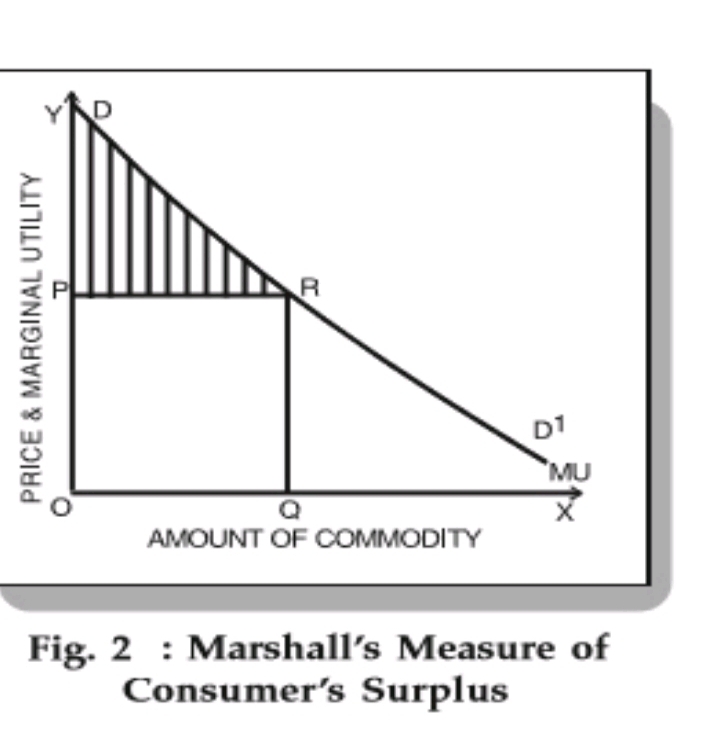Introduction:
The concept of Consumer’s Surplus was first invented by a French economist Dupuit in 1844. Later it was popularized by Prof. Alfred Marshall in 1980. Because of this consumer’s surplus is also called as Marshallian concept. The characteristics of consumers surplus are also called features.
In a monetary economy, we measure the utility of a commodity with the help of price. The price we pay for a commodity depends on its utility. If commodity possesses higher utility, then it commands higher prices and vice- versa.
The law of EMU states that the price paid for a commodity should be equal to its marginal utility. This is a basic condition for consumer’s equilibrium. At the point if equilibrium neither there will be higher utility nor lower utility. But MU=Price.
In real life a consumer may not act according to the law. The balance between the price and utility may not be maintained always. Sometimes he may get lower utility or higher utility from the commodity when compared to the price he is paying for it. The excess or surplus satisfaction enjoyed by a consumer over and above the price he is paying for a product rather than go without it is called as consumer’s surplus. It is found in the purchase of useful commodities like salt, matchbox, newspaper, and many other such durable and non-durable commodities.
According to Bilas, the difference between what the consumers does to pay for the commodity and what he would be willing to pay rather than go without it is called consumers surplus.
According to Prof. Taussing, consumer’s surplus is the difference between the potential price and actual price. It can be explain with the help of a simple formula.
Consumer’s Surplus= what we are prepared to pay – What we actually pay.
It is noted that there is an inverse relationship between price and consumer surplus. If price rises, consumer’s surplus falls and vice-versa. Consumer’s surplus is a product of opportunities and environment.
The concept of consumer’s surplus can be explained with the help of a table.
| Units of the commodities | M.U. of a commodity | Price per | Consumer’s Surplus in |
| 1 | 40 | 20 | 20 |
| 2 | 35 | 20 | 15 |
| 3 | 30 | 20 | 10 |
| 4 | 25 | 20 | 5 |
| 5 | 20 | 20 | nil |
| Total units | Total utility | Total Price | Consumer’s surplus |
Consumer’s Surplus= Total Utility- [price x Quantity]
Symbolically C.S. = TU-[PXQ]
= 150-[20X5]
=150-100=50
Thus the CS= what we are prepared to pay – what we actually pay.
CS = 200 – 150 =50.
Consumer surplus is a concept in economics that represents the difference between what consumers are willing to pay for a good or service and what they actually pay. It is essentially the surplus or benefit that consumers receive when they can purchase a product at a price lower than the maximum price they are willing to pay.
Characteristics of consumer surplus:
- Willingness to Pay (WTP):
- Consumer surplus is related to consumers’ willingness to pay for a good or service. Each consumer has a maximum price they are willing to pay, which is influenced by factors such as preferences, income, and the perceived value of the product.
- Market Price:
- The market price is the actual price at which the good or service is bought and sold in the market. This price is determined by the intersection of the demand and supply curves in a competitive market.
- Calculation:
- Consumer surplus is calculated as the area between the demand curve and the price level, up to the quantity of goods purchased. Graphically, it is the area of the triangle formed by the demand curve, the horizontal axis (quantity), and the vertical line representing the market price.
4. Graphical Representation:
- On a demand and supply graph, consumer surplus is the area between the demand curve and the price line above the equilibrium price. It reflects the value consumers receive in excess of what they actually pay.
- Aggregate Consumer Surplus:
- The aggregate consumer surplus for a market is the sum of individual consumer surpluses for all buyers in that market. It provides a measure of the overall welfare or benefit to consumers in a given market.
- Changes in Consumer Surplus:
- Consumer surplus can change due to shifts in demand, changes in supply, or shifts in market conditions. For example, an increase in supply or a decrease in demand can lead to an expansion of consumer surplus.

also read: explain the law of consumer equilibrium with the help of indifference curves.